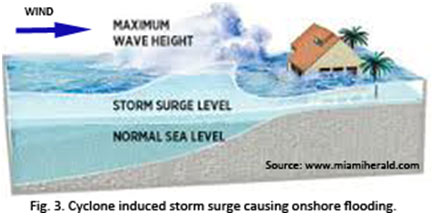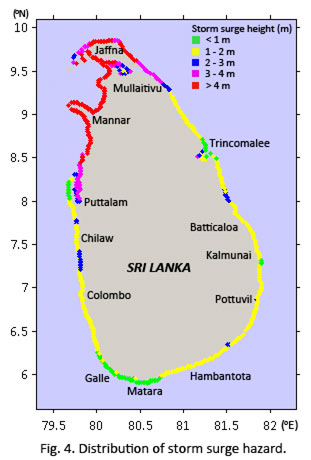 |
| |
| Cyclones and Storm Surges Pose a More Frequent Threat than Tsunami by Eng. (Dr) J. J. Wijetunge |
| |
| Background |
|
Tropical cyclones are low pressure systems that for mover warm tropical ocean waters and have sustained winds of 62 km per hour or greater near the centre. A satellite image of the tropical cyclone Nisha as it passed over South India and Sri Lanka in November 2008 is shown in Fig. 1. Many of these cyclones make landfall and can cause considerable loss of life and damage to property.
Sri Lanka is vulnerable to cyclones generated mostly in Bay of Bengal,and to a lesser extent, in Arabian Sea (Fig. 2). Some of the cyclones that form at low latitudes in Bay of Bengal move west or west-to-northwest into the Gulf of Mannar across Sri Lanka.On the other hand, a few of the cyclones that form in Southern Arabian Sea could also make landfall in the west coast of Sri Lanka. The months of November and December are the most cyclone-prone months for Sri Lanka.
|
| Cyclone induced storm surges |
| |
| Together with extreme winds, heavy rainfall and storm surge, land-falling tropical cyclones often cause immense death and destruction in vulnerable coasts. Usually, much of the death toll and damage to property in coastal areas is as a result of cyclone-induced storm surge causing inundation of low-lying coastal lands (Fig. 3). Storm surge is a rise of sea level caused mainly by pushing and consequent piling up of water against a coast under the action of high winds like those due to cyclones. The low pressure accompanying a cyclone also helps raise the sea water level further.The worst impacts occur when the storm surge arrives on top of a high tide .Waves generated by the powerful winds also contribute to a higher sea level. |
 |
|
The height of the storm surge depends on cyclone characteristics such as the wind speed,the pressure drop, the angle with which the cyclone crosses the coast as well as on the shape of the sea floor and the coastline. The surge of water so generated by the cyclone induced wind then rushes inland causing flooding. The severity and the extent of flooding depend primarily upon the surge height and the prevailing tide as well as the elevation, the slope and the roughness of the terrain. Owing to the dense population of the region, 26 of the world's 35deadliest tropical cyclones have occurred in the Bay of Bengal. A 10 metre high surge due to the Great Bhola Cyclone of 1970 in Bangladesh caused an estimated death toll of 300,000 to 550,000.Also, in Bangladesh, a cyclone in 1991 too resulted in a 6 metre high storm surge and a death toll of 138,000.
|
|
| Notable past cyclones across Sri Lanka |
|
According to the classification of revolving tropical systems adopted in Sri Lanka, maximum sustained wind speeds of 62 to 88 km per hour and 89 to 118 km per hour are categorized as cyclonic storms and severe cyclonic storms, respectively. Sixteen cyclones, of which five are severe cyclonic storms, are known to have crossed Sri Lanka during the past 130 years (see Table 1). Table 1 also gives the general area of formation of these cyclones as well as the coastal region of Sri Lanka where each cyclone made landfall. We see that, of the 16 cyclones that crossed Sri Lanka during the past 130 years, only two have been formed in Arabian Sea and made landfall in either western or northwestern coastlines of the country; the rest have all been formed in Bay of Bengal and made landfall on the north and east coasts. Of the five severe cyclonic storms, the systems that developed in December, 1964 and November, 1978 appear to have caused the most notable death and destruction. Only little information is available on the impact in terms of number of casualties and damage to property due to the severe cyclonic storms that crossed Sri Lanka in 1907, 1922 and 1931.
| Year/Month |
Classification |
Formed in |
Landfall |
| 1906 Jan |
Cyclonic Storm |
Bay of Bengal |
North |
| 1907 Mar |
Severe Cyclonic Storm |
Bay of Bengal |
East |
| 1908 Dec |
Cyclonic Storm |
Bay of Bengal |
North |
| 1912 Dec |
Cyclonic Storm |
Bay of Bengal |
South |
| 1913 Dec |
Cyclonic Storm |
Bay of Bengal |
South East |
| 1919 Dec |
Cyclonic Storm |
Bay of Bengal |
North |
| 1922 Nov |
Severe Cyclonic Storm |
Bay of Bengal |
East |
| 1925 Mar |
Cyclonic Storm |
Arabian Sea |
North West |
| 1931 Dec |
Severe Cyclonic Storm |
Bay of Bengal |
North |
| 1964 Dec |
Severe Cyclonic Storm |
Bay of Bengal |
East |
| 1966 Nov |
Cyclonic Storm |
Bay of Bengal |
East |
| 1967 Dec |
Cyclonic Storm |
Arabian Sea |
West |
| 1978 Nov |
Severe Cyclonic Storm |
Bay of Bengal |
East |
| 1980 Dec |
Cyclonic Storm |
Bay of Bengal |
East |
| 1992 Dec |
Severe Cyclonic Storm |
Bay of Bengal |
South East |
| 2000 Dec |
Severe Cyclonic Storm |
Bay of Bengal |
East |
| |
|
|
|
|
|
| Trincomalee cyclone of December 1964 |
|
The severe cyclonic storm that made landfall near Trincomalee on 23rd December, 1964 with reported maximum wind speeds of about 215 to 240 km per hour resulted in a death toll of about 650 with 400 missing in the northern province according to Dinamina newspaper of 25th December, 1964. The 1964 cyclone also induced a massive storm surge of height up to about 4.5 metres (15 feet)in the city of Mannar inundating and destroying low-lying coastal settlements and also contributing to the death toll. A detailed account of the impact of the storm surge is given in Ceylon Daily Mirror newspaper issued on the 29th December, 1964: “A fantastic tidal wave, rising fifteen feet over the land, whipped over the island of Mannar at the very height of the awesome cyclone. Today, six days after the event, only a sheet of water, subsiding ever so slowly, marks the place where once a city stood.” The powerful storm surge due to this cyclone also overturned a passenger train running between Pamban and Dhanushkody, 30 km west of Talaimannar, killingall 150 passengers on-board.
|
| Batticaloa cyclone of November 1978 |
|
The severe cyclonic storm that made landfall near Batticaloa on 24th November, 1978 with estimated maximum wind speeds of 222 km per hour caused loss of lives as well as extensive damage to housing and buildings and generated a storm surge of height 1 to 2 metres near Batticaloa with inland penetration of inundation reaching 1.5 km in Kalkudah (DMSL). The death toll attributed to this cyclone varies from 323 (Murty, 1986) to 915 (DMSL). The death toll due to the severe cyclonic storm that made landfall on 12th November, 1992 was only 4, with over 29,000 housing units damaged. The severe cyclonic storm that crossed Sri Lanka on 26th December, 2000 also resulted in 8 deaths and considerable property damage. In May 2003, a cyclone that did not cross Sri Lanka but moved further east, however,induced extremely heavy rainfall in some parts of Sri Lanka, resulting in about 250 to 300 deaths due to inland floods and landslides(DMSL). It must be added that the casualty and damage figures given above are usually due to the combined influence of one or more of the following cyclone related effects: storm surge, high winds, and heavy rainfall.
|
| Assessment of storm surge hazard for Sri Lanka |
|
However, unfortunately, no detailed analysis and assessment of the cyclone induced storm surge hazard has been carried out for the coastline of Sri Lanka. Clearly, information gathered from such an assessment would provide the basis for disaster risk mitigation policy planning and decision making in regard to the cyclonic storm surge hazard for Sri Lanka. Such a storm surge hazard assessment for the entire country has been carried out by the author (Wijetunge, 2013a). The study first utilized a statistical analysis of the pertinent past cyclone events in Bay of Bengal and Arabian Sea during the last century to determine appropriate cyclone scenarios with corresponding recurrence intervals. Then computer simulations were performed to model a large number of probable paths of a cyclone of maximum sustained wind speed 220 km per hour as well as the hydrodynamics of the respective storm surges around the coastline of the country. The peak surge heights from these simulations were extracted to derive a composite of storm surge heights off the seaboard of Sri Lanka.
|
 |
| |
|
|
Accordingly, Fig. 4 shows the distribution of the storm surge hazard around the coastline of Sri Lanka (maximum surge heights above Mean Sea Level) corresponding to a tropical cyclone of peak wind speed 220 km per hour with an estimated recurrence interval of about 100 years. Clearly, the northwestern and northern coastal areas of Sri Lanka are likely to experience more severe flooding caused by storm surges than the south and the west. The shallow bathymetry and the wider continental shelf fronting the north and northwest are primarily responsible for the higher level of surge heights. On the other hand, the southwestern coastal areas are exposed to a lower level of storm surge hazard. Note that, although there is a higher chance of cyclones making landfall on the eastern and northeastern coasts than the west, cyclones induce surges not only at landfall but whilst exiting a coastline as well. (Wijetunge, 2013b)
It is therefore clear that several severe cyclones have hit Sri Lanka during the past century, with those in 1964 and 1978 being the worst, resulting in loss of lives of the order of several hundred as well as considerable damage to housing and other infrastructure due to both the surge and the high winds. In comparison, the death toll in Sri Lanka due to the tsunami inundation in December 2004 was of the order of several tens of thousands, however, a tsunami event of such magnitude is extremely rare, expected only once every several centuries. So, tropical cyclone induced storm surges appear to pose a more frequent, albeit comparatively less severe, threat of flooding in most parts of the coastline of Sri Lanka than tsunami. Nevertheless, it must be noted that the severity of the storm surge hazard could be greater even compared to the tsunami for certain parts of the coastline of Sri Lanka. For example, the city of Mannar and the nearby localities are probably more at risk of coastal flooding due to storm surges than tsunami. So, whilst improving our tsunami preparedness in coastal areas, we must also pay due attention to the potential threat from other hazards such as coastal flooding due to cyclone induced storm surges as well.
Eng. (Dr) J. J. Wijetunge, BSc (Eng), PhD (Cambridge), C. Eng.
Senior Lecturer, Faculty of Engineering
University of Peradeniya
janakaw@pdn.ac.lk
|
| Reference |
| DMSL.Cyclone events since 1900.Department of Meteorology, Sri Lanka. |
| Murty, T.S., 1986. The storm surge problem in the Bay of Bengal.Prog.Oceanog., 16: 195-233. |
| Wijetunge J. J., 2013a. A multi-scenario analysis of the storm surge hazard for Sri Lanka.Proc. 35th IAHR Congress, Tsinghua University Press, Beijing. |
| Wijetunge J. J., 2013b.An Introduction to Coastal Engineering: Processes, Theory, Hazards and Design Practice, S. Godage Publishers, Colombo. |
Page Top
|
|
|